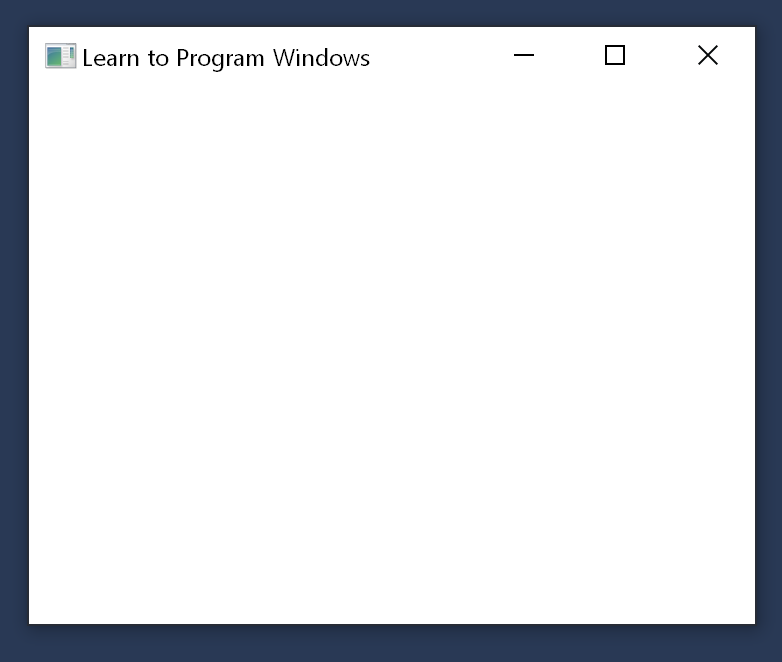模块 1. 你的第一个 Windows 程序
在本模块中,我们将编写一个最小的 Windows 桌面程序。 它所做的就是创建并显示一个空白窗口。 第一个程序包含大约 50 行代码,不计算空白行和注释。 这将是我们的起点:稍后我们将添加图形、文本、用户输入和其他功能。
若要详细了解如何在 Visual Studio 中创建传统 Windows 桌面应用程序,请查看 演练:创建传统的 Windows 桌面应用程序(C++)。

下面是程序的完整代码:
#ifndef UNICODE
#define UNICODE
#endif
#include <windows.h>
LRESULT CALLBACK WindowProc(HWND hwnd, UINT uMsg, WPARAM wParam, LPARAM lParam);
int WINAPI wWinMain(HINSTANCE hInstance, HINSTANCE hPrevInstance, PWSTR pCmdLine, int nCmdShow)
{
// Register the window class.
const wchar_t CLASS_NAME[] = L"Sample Window Class";
WNDCLASS wc = { };
wc.lpfnWndProc = WindowProc;
wc.hInstance = hInstance;
wc.lpszClassName = CLASS_NAME;
RegisterClass(&wc);
// Create the window.
HWND hwnd = CreateWindowEx(
0, // Optional window styles.
CLASS_NAME, // Window class
L"Learn to Program Windows", // Window text
WS_OVERLAPPEDWINDOW, // Window style
// Size and position
CW_USEDEFAULT, CW_USEDEFAULT, CW_USEDEFAULT, CW_USEDEFAULT,
NULL, // Parent window
NULL, // Menu
hInstance, // Instance handle
NULL // Additional application data
);
if (hwnd == NULL)
{
return 0;
}
ShowWindow(hwnd, nCmdShow);
// Run the message loop.
MSG msg = { };
while (GetMessage(&msg, NULL, 0, 0) > 0)
{
TranslateMessage(&msg);
DispatchMessage(&msg);
}
return 0;
}
LRESULT CALLBACK WindowProc(HWND hwnd, UINT uMsg, WPARAM wParam, LPARAM lParam)
{
switch (uMsg)
{
case WM_DESTROY:
PostQuitMessage(0);
return 0;
case WM_PAINT:
{
PAINTSTRUCT ps;
HDC hdc = BeginPaint(hwnd, &ps);
// All painting occurs here, between BeginPaint and EndPaint.
FillRect(hdc, &ps.rcPaint, (HBRUSH) (COLOR_WINDOW+1));
EndPaint(hwnd, &ps);
}
return 0;
}
return DefWindowProc(hwnd, uMsg, wParam, lParam);
}
可以从 Windows Hello World 示例下载完整的 Visual Studio 项目。
简要概述了此代码的作用可能很有用。 后面的主题将详细介绍代码。
-
wWinMain 是程序入口点。 程序启动时,它会注册有关应用程序窗口行为的一些信息。 最重要的项之一是在此示例中名为
WindowProc的函数的地址。 此函数定义窗口的行为 -- 其外观、它如何与用户交互,等等。 - 接下来,程序创建窗口并接收唯一标识窗口的句柄。
- 如果窗口已成功创建,则程序在 循环时输入。 程序将保留在此循环中,直到用户关闭窗口并退出应用程序。
请注意,程序不会显式调用 WindowProc 函数,尽管我们表示这是定义大部分应用程序逻辑的位置。 Windows 通过向其传递一系列 消息来与程序通信。
循环驱动此过程时, 中的代码。 每次程序调用 DispatchMessage 函数时,它都会间接导致 Windows 为每个消息调用 WindowProc 函数一次。
在本部分中
相关主题
-
学习 C++ 中的 Windows 程序